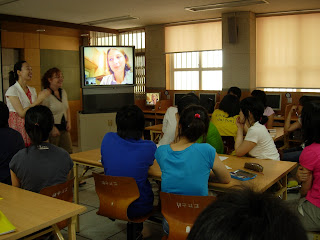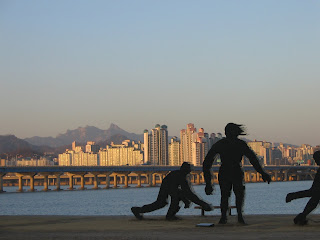
Dear Friends and Family,
Before returning with you all to the DMZ and in order to share my impressions (including why I used the adjective “menace” in describing North Korea), I need to shore up my conclusions by providing you all with my partial and prejudicial and likely boorish version of Korean history.
As you may recall, Korea, by definition, is a geographical peninsula filled with people sharing a common language and long-standing culture. Koreans have a rough history with “outsiders” – a history chock full of invasions by Mongolians or Japanese, a long bout of paying costly homage to China, and a habit of protecting its culture through isolating itself from the rest of the world. Enter modern times and the crucial point of 1910, when the Japanese colonized Korea and ruled in a decidedly non-benevolent style for 35 years (stripping Koreans of their ability to be Korean - down to changing their names to Japanese names) until the end of World War II in 1945.
In order to accept the Japanese capitulation and to assist in stabilizing Korea during a post-colonial governmental transition, American forces occupied Korea up to the 38th parallel while the Soviets occupied Korea down to the 38th parallel. Afterwards, the two armies, once united by opposing Japan and Germany but separated by ideologically opposing governments, could not agree on a forward course. So each occupier-ally helped Korea set-up a government: the US attempted to spread “democracy” to the South and in 1948, held an election that selected President Syngman Rhee while the Soviets appointed a charismatic leader by the name of Kim, Il-Sung to head-up the Communist Korean state.
The lack of agreement regarding which government was legit effectively divided Koreans in half. Neither government intended to rule only half the peninsula but neither could an agreement to unite be reached. Eventually North Korea, with superior resources and inferior patience, crossed the 38th parallel to attack South Korea on June 25, 1950. Thus began Koreans fighting Koreans in a civil war. But when it looked as if the “Democratic” South would loose out to the Communist North, the United States and the United Nations entered the fray to battle back the communists, inspiring China to eventually throw its weight behind the North. In three years, millions died, no side was able to assert dominance over the entire peninsula, the country was devastated in every possible way, and finally a cease-fire was signed on July 27, 1953.
The cease-fire, such as it was, still holds today. The Korean War has never officially ended.
I think it safe to say that following the Korean War, the South distracted itself by cleaning itself up, writing a constitution that included a future unification with the North, and diligently working towards a mighty capitalist society – even to the point of engaging, when fruitful, with the outside world. While the North built itself into communist military economy focused on “freeing the South” (from the repressive Americans), closed off to all but a few of its closest friends (communist China and Soviet Union), and talked itself into believing that it was a utopia ruled by the benevolent and brilliant Kim, Il-Sung. It is not truly known how North Koreans felt or feel about their utopian state but it is believed that North Koreans feel the separation of Korea as keenly as the South feels it – and that North Koreans can reliably be rallied around all “free the South” campaigns. Thus began the history of North Korea holding its people utilizing love/hate feelings for the South. It was not long after the cease-fire that a steadily increasing number of “liberating” attacks by the North on the South began.
Open – almost - hostility returned to the fore in 1968. In January 1968, 31 North Korean soldiers dressed in South Korean uniforms covertly slipped through the DMZ and moved south to the Korean Presidential Palace – Blue House – before being detected and arrested a mere block from the palace on the 22nd. This caused considerable outrage from the South Koreans, who garnered immediate, visible backing from the United States to the point that within a day, on January 23, 1968, a Navy intelligence vessel dubbed the
USS Pueblo was surrounded and seized by the North Koreans in international waters – resulting in an 11 month hostage situation. In fact, 1968 was generally not a good year for Korea; accordingly to one source, there were 700 or so attacks that year although the number of attacks fell the following year to 300 as visible tension subsided.
Out-right hostility returned again in the 1970s. The US military at the DMZ’s Joint Security Area decided to trim back a sizeable poplar tree that dangerously (according to them) isolated 1 of their guard towers amongst 3 North Korean guard towers. On August 18th, 1976, a Korean work force was escorted by a few US soldiers to trim the large poplar tree. The group was surrounded by 30 North Korean soldiers operating under the impression that the tree was sacred to Kim, Il-Sung. The end result was that the tree remained intact while 2 US soldiers were beaten to death with the blunt end of axes. This resulted in the most militarized tree removal in history dubbed “Operation Paul Bunyan”: the poplar tree was removed and replaced with a monument to the dead soldiers. The workers sent to dispense of the tree were backed by helicopters, a number of B-52 bombers, and an entire army platoon. Happily, North Korea did not send soldiers to stop the cutting, so only a tree fell to axes that day.
It was also in the 1970s when North Korean defectors started talking about secret tunnels and upon following up, South Koreans began discovering incursion tunnels, running North to South directly under the DMZ. The tunnels were detected using water-filled holes dug vertically in the ground near the suspected tunnel locations. A sharp-eyed RoK soldier spotted water trembling in one hole (the movement was caused by the dynamite used to blast out the first discovered tunnel) in November of 1974. Other tunnels were discovered in 1975, 1978, and 1990 totaling up to four known incursion tunnels under the DMZ. And these tunnels were just a little too good to not be real. It was estimated that an entire regiment could pass through the tunnel in an hour. And individual studies of each tunnel showed design progressed with each tunnel. For example, the first tunnel has a bit of a water retention problem while the third tunnel slopes slightly up so that water does not stagnate. Clearly these tunnels were for more than amusement. Luckily, the North Koreans provided some always welcome macabre amusement with their explanation for the tunnels. The North claimed that the tunnels’ purpose was coal mining – although the black on the tunnel walls was easily identified as… paint. No trace of coal has ever been found in the tunnels.
And rather surprisingly, especially to us who are hyperaware of the fanfare and seeming success surrounding the Sunshine Policy, liberating attacks from the North Koreans continue almost to this day. In 1998, the body of a North Korean was found on a beach just south of the DMZ, along with equipment suggesting a non-friendly mission. And if my memory doesn’t deceive me, as late as in 2004, a North Korean submarine was caught near in the very South Korean waters near Jeju Island. (I found this tidbit in a museum but cannot confirm it).
Summed up, this partial, prejudiced history adds up to the idea that North Korea has spent fifty-four years planning attacks on South Korea while ruled by an authoritarian government that has raised generations of North Koreans to believe that Kim, Il-Sung is more miraculous than God and that actively believe that South Korea contains the enemy. Here in 2007, the North Korea leadership, now starving its people of food and other necessities, is in need of a certain level of hostility with South Korea and the United States to give its government purpose. The malice against the US, against South Korea is ingrained in North Korea, it will endure.
All of this is why I came to feel that North Korea is menacing, much like a thundercloud hovering in the distance, poised to wildly strike. I wouldn’t go so far as to say that war is inevitable… but a peaceable solution to the Korean War seems far away.
And now back to the DMZ….
Regretfully yours,
Laura

 Dear Family and Friends,
Dear Family and Friends, 



























